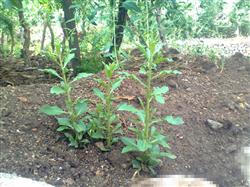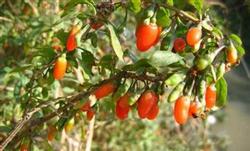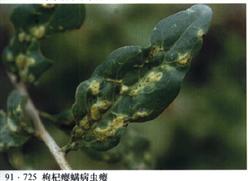Management of juvenile stage of Lycium barbarum

After the seedlings planted by fixed stem pruning sprout, the buds below 30 cm above the trunk basal stem (branch band) are cut off. Above the branch belt, 3-5 lateral buds or lateral branches growing in different directions and 3 cm-5 cm apart are selected as the backbone branches (the first layer crown of the crown) to form a small crown, and the top is cut at the height of 40 cm-50 cm. From late May to late July, the sprouting shoots below the main branch band were cut off every 15 days, and the lateral branches left above the branch belt were cut short where the branch length was 20 cm, so as to promote the germination of secondary branches. The strong branches (middle branches) growing upward on the lateral branches (middle branches) were selected from 2 to 3 branches in different directions of the main trunk (each 10 cm apart) as the main branches of the crown, and the top was cut at 30 cm to promote the secondary branches to bear autumn fruit. In the newly built Chinese wolfberry orchard, 100 grams of nitrogen and phosphorus compound fertilizer was applied in early July, 100 grams of urea was applied in the middle of April, 150 grams of nitrogen and phosphorus compound fertilizer was applied in the first ten days of June, and 150 grams and 200 grams of nitrogen and phosphorus fertilizer were applied in the middle of July. The method is to open a ditch at the outer edge of the crown 10 cm-15 cm deep and 30 cm long, apply a quantitative amount of chemical fertilizer into the ditch, mix it with the soil and seal the ditch for irrigation. Autumn application of basic fertilizer is carried out from late September to early October. Symmetrical pits are opened along the outer edge of the crown. The pit length is 30 cm-50 cm (depending on the size of the crown) and the pit depth is 30 cm. Each plant applied cake fertilizer 2 kg-5 kg, sheep dung 5 kg-15 kg (depending on the age of the tree), diammonium 150 grams, mixed with soil, sealed pit, ready to irrigate winter water. Foliar fertilizer for 2-4 years, Chinese wolfberry plants were sprayed with auxin (Ye Mianbao, Fengshu, etc.) in May, June, July and mid-August respectively, 30 kg-50 kg aqueous solution per mu. Timely pest control aphids using 50% monocrotophos 1000-2000 times or 40% omethoate 1000 times solution crown spray; control negative mud insects 20% fenvalerate 2000 times-3000 times solution crown spray; control rust mites using sulfur glue 500x solution crown spray. During the annual growth period of timely irrigation (April-September), the water intake is 50 cubic meters per mu, and 70 cubic meters per mu of winter water (early November). Ploughing and weeding 4 times from May to August, with a depth of 15 cm; turning the garden once in September, with a depth of 25 cm, 15 cm under the crown, without damaging the basal stem of the plant. The overgrown branches from the rhizome, trunk and canopy of the plant in September were pruned in autumn.
- Prev

Cultivation techniques of Lycium barbarum in Ningxia
Chinese wolfberry is a plant of Solanaceae and Lycium barbarum, alias Chinese wolfberry vegetable, Chinese wolfberry head, etc., rich in protein, amino acids, carbohydrates, a variety of vitamins, fruit as medicine, it has the effect of nourishing yin and tonifying kidney, tonifying qi and calming mind, strengthening body, delaying aging, and can treat diabetes, chronic hepatitis, tuberculosis and other diseases. Ningxia wolfberry.
- Next

Application and cultivation of Lycium barbarum
In the middle and last ten days of August 2002, Chinese wolfberry gall mite disease occurred in the Chinese wolfberry producing area along the boundary between giant deer and Longyao, which brought great losses to the majority of Chinese wolfberry growers. Harmful symptoms: the leaf is the most obvious, the injured site is dense yellowish green, nearly round bulge dot, the leaf is twisted, similar to virus disease, the plant growth is seriously hindered, the leaf.
Related
- Fuxing push coffee new agricultural production and marketing class: lack of small-scale processing plants
- Jujube rice field leisure farm deep ploughing Yilan for five years to create a space for organic food and play
- Nongyu Farm-A trial of organic papaya for brave women with advanced technology
- Four points for attention in the prevention and control of diseases and insect pests of edible fungi
- How to add nutrient solution to Edible Fungi
- Is there any good way to control edible fungus mites?
- Open Inoculation Technology of Edible Fungi
- Is there any clever way to use fertilizer for edible fungus in winter?
- What agents are used to kill the pathogens of edible fungi in the mushroom shed?
- Rapid drying of Edible Fungi

